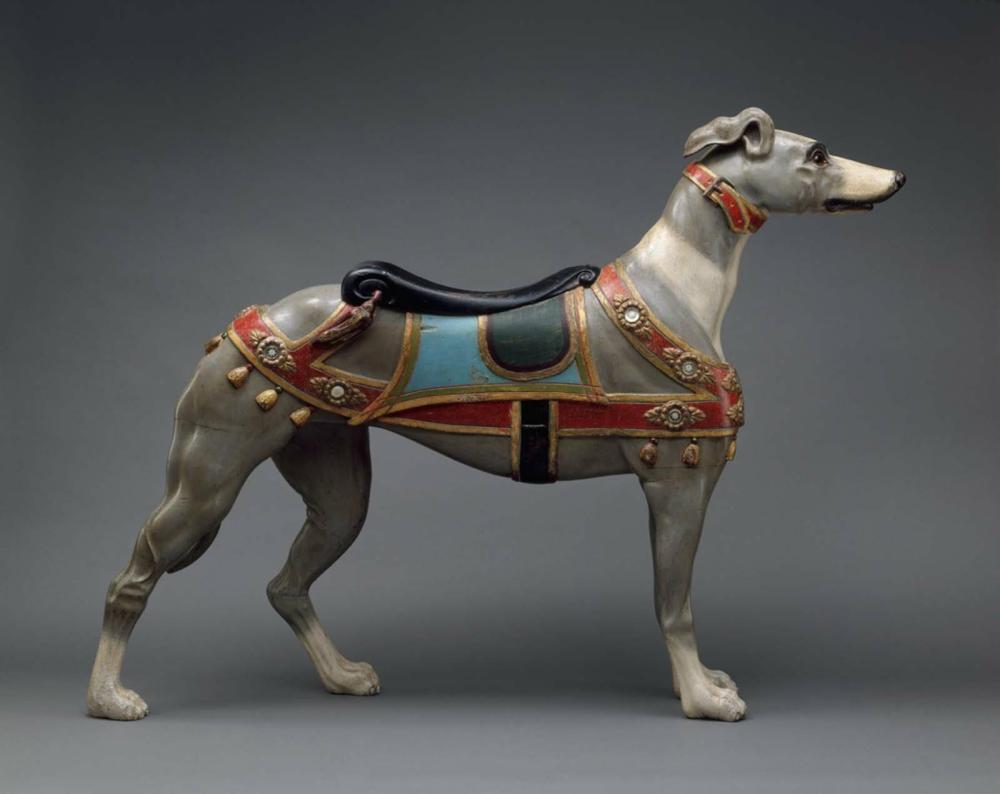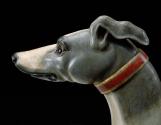Advanced Search
Greyhound (Carousel Figure)
Charles I. D. Looff (1852–1918)
about 1905–10
Object Place: Providence, Rhode Island, United States
Medium/Technique
Carved wood with original polychrome decoration; glass eyes
Dimensions
137.16 x 38.1 x 185.42 cm (54 x 15 x 73 in.)
Credit Line
Gift of Claire M. and Robert N. Ganz
Accession Number1992.267
CollectionsAmericas
ClassificationsSculpture
During the heyday of the carousel (or merry-go-round) as a popular form of American entertainment, from the 1890s into at least the 1920s, as many as three thousand carousels were installed at amusement parks across the country. Many of the finest carvers of carousel animals were German immigrants, including Charles Looff, whose name is stamped on the belly of this colorful, imposing greyhound.
Looff was born in Schleswig-Holstein on the border between Denmark and Germany and moved to New York in 1870 as a young man of eighteen. He found employment first as a furniture carver, and, according to tradition, carved carousel figures in the evenings as a hobby. Within five years, he opened his first carousel at Coney Island, and in 1880 he established a carousel factory in Brooklyn. The plant remained in operation there until Looff shifted his headquarters to the Crescent Park Hippodrome in Riverside, Rhode Island, about 1904-5. This greyhound is marked "Riverside" and was thus made there between 1905 and 1910, when Looff moved his factory to California.
Looff's factories produced an extensive menagerie of animals, including a small number of greyhounds-perhaps only a dozen-all said to be modeled on a family pet. This example is a large "stander," used on the outer ring of the carousel. Its "romance" side (the side exposed to the outside as the carousel rotates counterclockwise) is richly embellished with carved details, applied tassels, and cut-glass decoration. When acquired by the Museum, the greyhound was painted dark brown and covered with a thick layer of varnish. A painstaking process of conservation removed about fourteen layers of paint (carousel figures were exposed to the weather and thus repainted frequently), revealing the original polychrome painted surface and other details.
This text was adapted from Ward, et al., MFA Highlights: American Decorative Arts & Sculpture (Boston, 2006) available at www.mfashop.com/mfa-publications.html.
Looff was born in Schleswig-Holstein on the border between Denmark and Germany and moved to New York in 1870 as a young man of eighteen. He found employment first as a furniture carver, and, according to tradition, carved carousel figures in the evenings as a hobby. Within five years, he opened his first carousel at Coney Island, and in 1880 he established a carousel factory in Brooklyn. The plant remained in operation there until Looff shifted his headquarters to the Crescent Park Hippodrome in Riverside, Rhode Island, about 1904-5. This greyhound is marked "Riverside" and was thus made there between 1905 and 1910, when Looff moved his factory to California.
Looff's factories produced an extensive menagerie of animals, including a small number of greyhounds-perhaps only a dozen-all said to be modeled on a family pet. This example is a large "stander," used on the outer ring of the carousel. Its "romance" side (the side exposed to the outside as the carousel rotates counterclockwise) is richly embellished with carved details, applied tassels, and cut-glass decoration. When acquired by the Museum, the greyhound was painted dark brown and covered with a thick layer of varnish. A painstaking process of conservation removed about fourteen layers of paint (carousel figures were exposed to the weather and thus repainted frequently), revealing the original polychrome painted surface and other details.
This text was adapted from Ward, et al., MFA Highlights: American Decorative Arts & Sculpture (Boston, 2006) available at www.mfashop.com/mfa-publications.html.
ProvenanceDr Robert Ganz; Mr. Hallett Tobin, 1965; Thunderbird Amusements (Mr. Ricky), 1965; Pete Sutton, Great Sutton Shows




